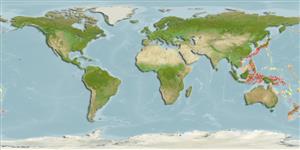Environment: milieu / climate zone / depth range / distribution range
Écologie
marin bathydémersal; profondeur 250 - 300 m (Ref. 28016). Deep-water
Western Pacific: southern Japan to the South China Sea except Ryukyu Islands.
Taille / Poids / Âge
Maturity: Lm ? range ? - ? cm
Max length : 18.0 cm TL mâle / non sexé; (Ref. 2272)
Description synthétique
Clés d'identification | Morphologie | Morphométrie
Épines dorsales (Total) : 4 - 6; Rayons mous dorsaux (Total) : 13 - 15; Rayons mous anaux: 13 - 15; Vertèbres: 26. Lower edge of preopercle with 3 spines, very rarely to be more. Labial fimbriae simple and poorly developed. Posterior nostril slitlike. Dorsoposterior margin of pectoral fin slightly concave; pectoral and caudal fins pale yellow in fresh specimens. Fifth proximal anal pterygiophore (the first to follow a complete haemal spine) usually inserts between the haemal spines of 13th and 14th vertebrae (Ref. 11439).
Found near shore, down to 260 m, on sand and sandy mud bottoms (Ref. 11230). Spend a large part of their time buried in the mud or sand with only their eyes and a portion of the mouth protruding (Ref. 4716). Cleithral spine with venom gland (Ref. 57406).
Life cycle and mating behavior
Maturité | Reproduction | Frai | Œufs | Fécondité | Larves
Masuda, H., K. Amaoka, C. Araga, T. Uyeno and T. Yoshino, 1984. The fishes of the Japanese Archipelago. Vol. 1. Tokai University Press, Tokyo, Japan. 437 p. (text). (Ref. 559)
Statut dans la liste rouge de l'IUCN (Ref. 130435: Version 2024-2)
Utilisations par l'homme
Pêcheries: commercial; Aquarium: Commercial
Outils
Articles particuliers
Télécharger en XML
Sources Internet
Estimates based on models
Preferred temperature (Ref.
123201): 1.8 - 14.9, mean 12.4 °C (based on 26 cells).
Phylogenetic diversity index (Ref.
82804): PD
50 = 0.5000 [Uniqueness, from 0.5 = low to 2.0 = high].
Bayesian length-weight: a=0.00794 (0.00322 - 0.01959), b=3.09 (2.89 - 3.29), in cm total length, based on LWR estimates for this Genus-body shape (Ref.
93245).
Niveau trophique (Ref.
69278): 3.9 ±0.7 se; based on size and trophs of closest relatives
Résilience (Ref.
120179): Milieu, temps minimum de doublement de population : 1,4 à 4,4 années (Assuming tmax>3).
Fishing Vulnerability (Ref.
59153): Low vulnerability (10 of 100).
